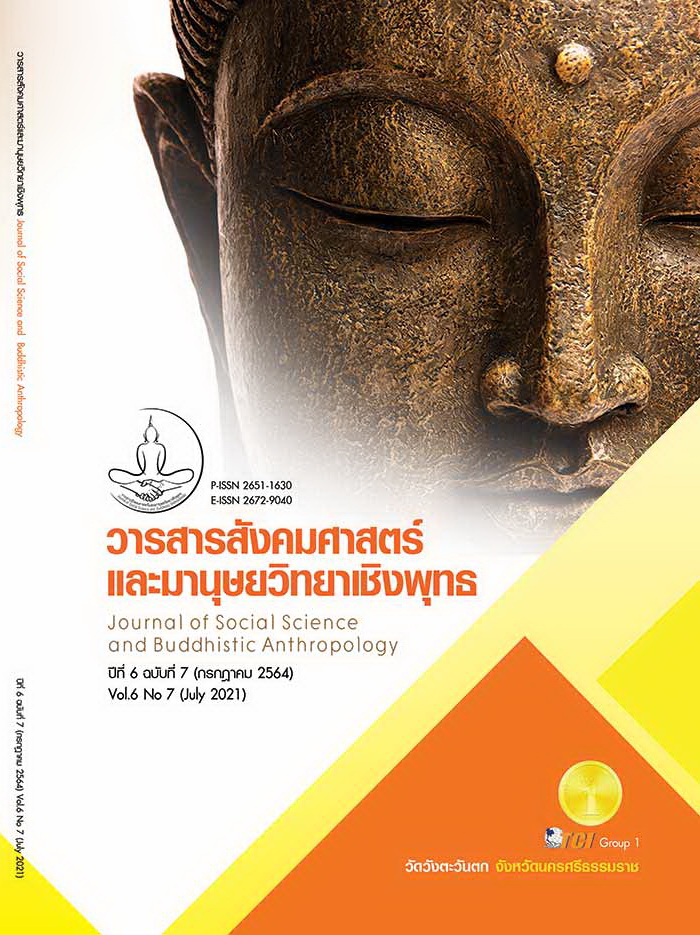INTEGRATED COMMUNICATION MODEL FOR THE PROPAGATION OF BUDDHIST PRINCIPLES IN THAILAND
Keywords:
Communication Model, Integration for Principle Propagation, Focus on Buddhism, BuddhismAbstract
The objectives of this research article were to: 1) Study the factors affecting the integrated communication for the dissemination of Buddhist principles. And Buddhist merit making, 2) build a causal relationship model for integrated communication for the spread of Buddhist principles and Buddhist merit making, and 3) Analyzing and integrating the consistency of causal model of communication the advantages of Buddhism. This was an integrated research design for mixed method: quantitative using questionnaires, stratified random sampling. The sample group includes: an involved in the dharma practice bureau of 400 peoples. By using analyzed frequency, percentage, mean, standard deviation, Skewness, Kurtosis. And qualitative In-depth interviews by purposive sampling, key informants such as: administrators, academics and Buddhist of 7 peoples. By analyzing the content and summarizing. The research was found that: 1) There are factors that affect communication has 5 spread: 1.1) Buddhist merit making ( = 4.361, S.D. = 0.558), 1.2) Buddhist attributes (
= 4.330, S.D. = 0.569), 1.3) focusing on Buddhist propagation (
= 4.257, S.D. = 0.581), 1.4) Focusing on Buddhism (
= 4.161, S.D. = 0.571), and 1.5) integrated communication (
= 3.806, S.D. = 0.631). 2) The results show that the consistency of the model has a great influence of Chi - Square = 0.000, df = 0, GFI = 1.000. And 3) Analyzing and integrating the consistency are the model consistent with the empirical data Chi - square = 71.201, df = 54, p = 0.058, GFI = 0.975, AGFI = 0.952, SRMR = 0.017, RMSEA = 0.028 and CFI = 1.00. The model is considered appropriate and acceptable.
References
นักวิชาการ. (9 กันยายน 2563). แบบจำลองการสื่อสารแบบบูรณาการเพื่อการเผยแผ่หลักธรรมทางพระพุทธศาสนาในประเทศไทย. (นิพนธ์ เพียรนาค และวิชิต อู่อ้น, ผู้สัมภาษณ์)
บุญชม ศรีสะอาด. (2556). วิธีการทางสถิติสำหรับการวิจัย. (เล่มที่ 2). กรุงเทพมหานคร: สุวีริยาการพิมพ์.
ผู้บริหาร. (9 กันยายน 2563). แบบจำลองการสื่อสารแบบบูรณาการเพื่อการเผยแผ่หลักธรรมทางพระพุทธศาสนาในประเทศไทย. (นิพนธ์ เพียรนาค และวิชิต อู่อ้น, ผู้สัมภาษณ์)
พระมหาจักรพล สิริธโร. (2563). การเผยแผ่พุทธศาสนา ในยุคไทยแลนด์ 4.0. วารสารสถาบันวิจัยญาณสังวร, 11(1), 80-90.
พระมหานันทะการณ์ เดือยพิมพ์ และวิชิต อู่อ้น. (2562). แบบจำลองการสื่อสารหลักธรรมด้วยการสื่อสารการตลาด เชิงบูรณาการที่ส่งผลต่อความสุขของพุทธศาสนิกชน. วารสารมหาจุฬานาครทรรศน์, 6(9), 4311-4331.
พระโสภณสมาธิคุณ วิ (จำลอง อชิโต). (2559). “ปุญญกถา” ธรรมะจากธรรมาสน์ เล่ม 3. กรุงเทพมหานคร: กรมการศาสนา กระทรวงวัฒนธรรม.
พุทธศาสนิกชนที่ปฏิบัติธรรม. (9 กันยายน 2563). แบบจำลองการสื่อสารแบบบูรณาการเพื่อการเผยแผ่หลักธรรมทางพระพุทธศาสนาในประเทศไทย. (นิพนธ์ เพียรนาค และวิชิต อู่อ้น, ผู้สัมภาษณ์)
สำนักงานพระพุทธศาสนาแห่งชาติ. (2563). สถิติศาสนา ศิลปะ วัฒนธรรม. เรียกใช้เมื่อ 29 กันยายน 2563 จาก http://statbbi.nso.go.th/staticreport/page/sector/th/04.aspx
สำนักงานสถิติแห่งชาติ. (2559). สำนักงานสถิติแห่งชาติพร้อมเดินหน้าเชื่อมโยงข้อมูลภาครัฐสู่การพัฒนาอย่างยั่งยืน. สารสถิติ, 28(2), 1-15.
Cronbach, L. J. (1990). Essentials of psychological testing. (5th ed.). New York: Harper Collins. Publishers.
Duncan, T. R. & Everett, S. R. (2005). Client Perceptions of Integrated Marketing Communications. Journal of Advertising Research, 33(3), 30-39.
Eagle, L. et al. (1999). Perceptions of integrated marketing communications among marketers & ad agency executives in New Zealand. International Journal of Advertising, 18(1), 89-119.
Kliatchko, J. (2008). Revisiting the IMC construct: A revised definition and four pillars. International Journal of Advertising, 27(1), 133-160.
Krejcie, R. V. & Morgan, D. W. (1970). Determining Sample Size for Research Activities. Educational and Psychological Measurement, 30(3). 607-610.
Likert, R. (1967). The Method of Constructing and Attitude Scale. In Reading in Fishbeic, M (Ed.), Attitude Theory and Measurement (pp. 90-95). New York: Wiley & Son.
Luo, X. & Donthu, N. (2006). Marketing’s Credibility: A Longitudinal Investigation of Marketing Communication Productivity and Shareholder Value. Journal of Marketing, 70(4), 70-91.
Luxton, R. & Mavondo, F. (2014). Integrated Marketing Communication Capability and Brand Performance. Journal of Advertising, 44(1), 37-46.
Osinga, E. C. et al. (2011). Why Do Firms Invest in ConsumerAdvertising with Limited Sales Response? A ShareholderPerspective. Journal of Marketing, 75 (January), 109–124.
Xue, F. & Zhou, P. (2011). The Effects of Product Involvement and Prior Experience On Chinese Consumers' Responses to Online Word of Mouth. Journal of International Consumer Marketing, 23(1), 45-58.








